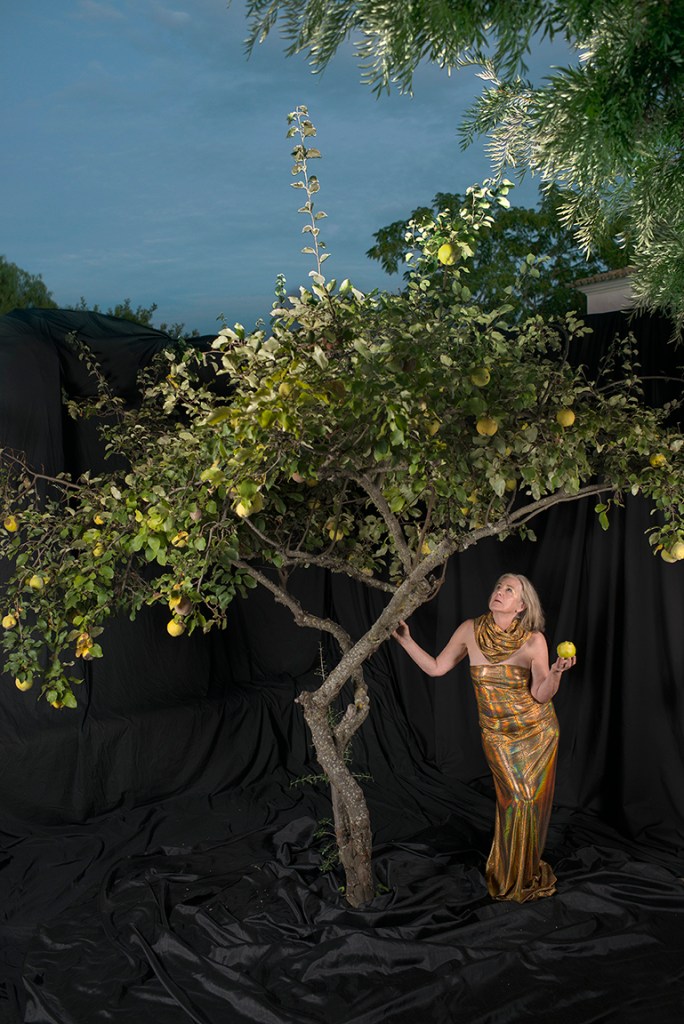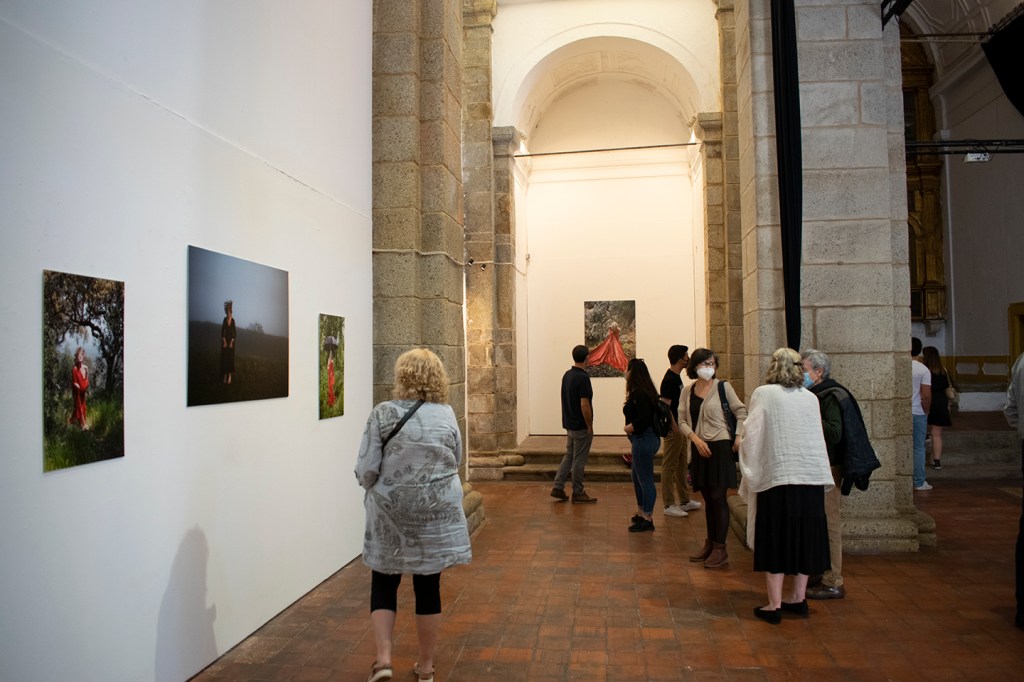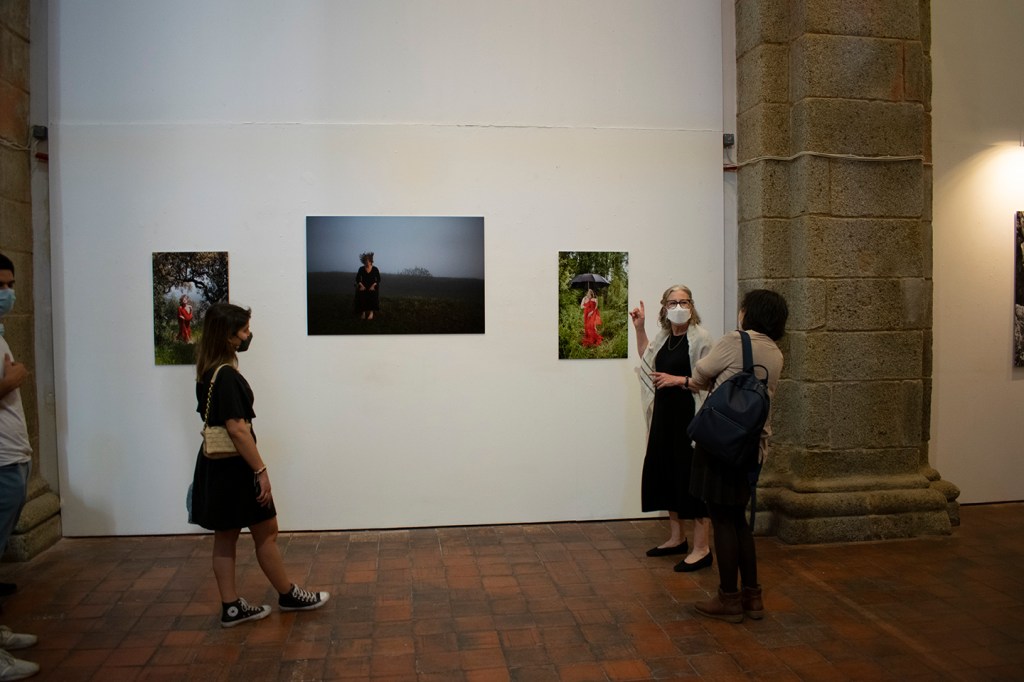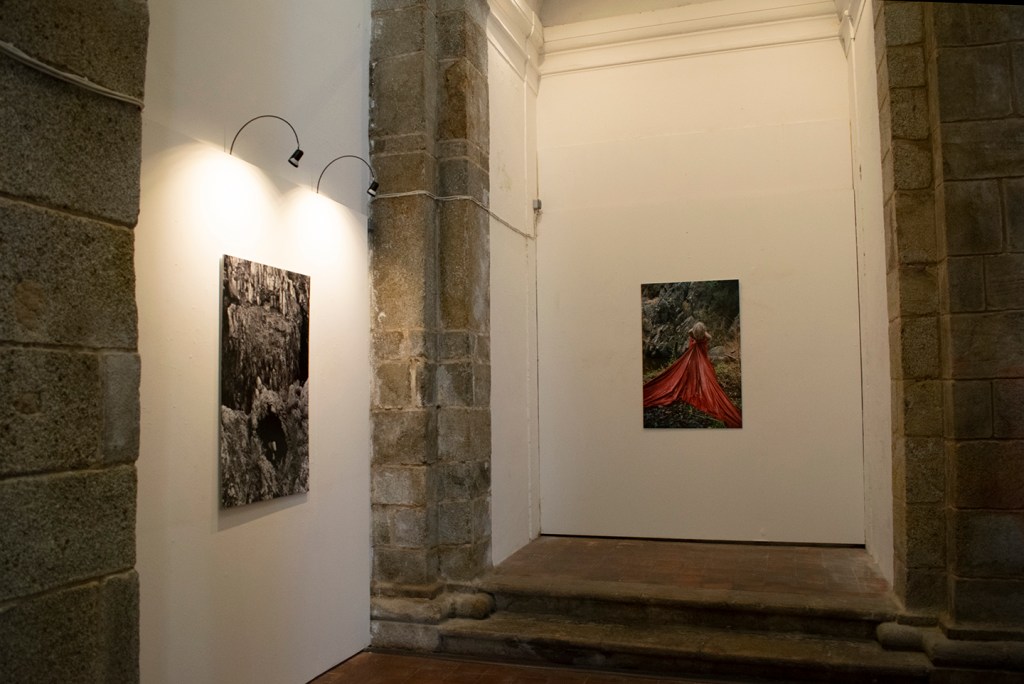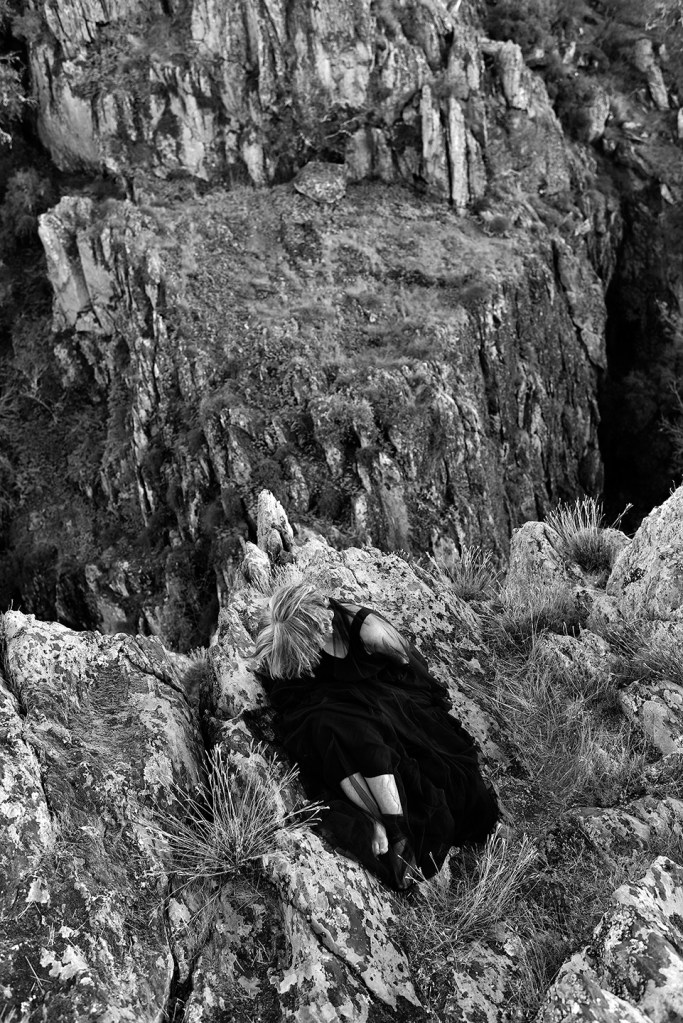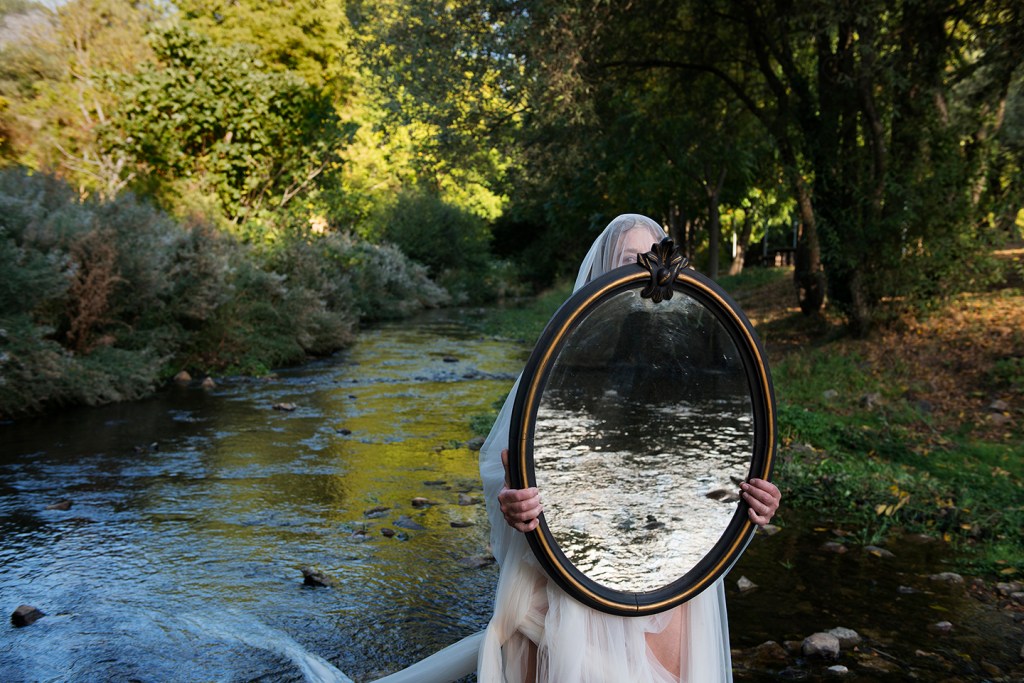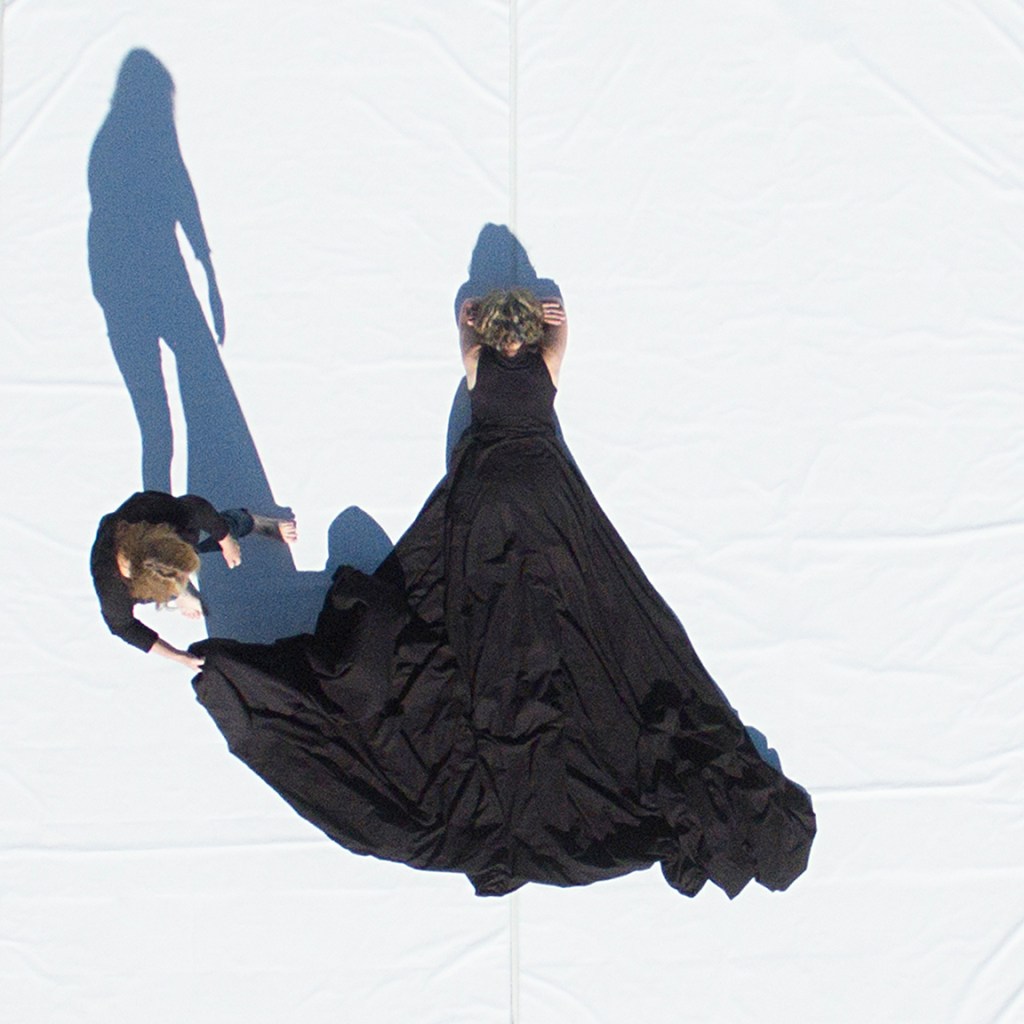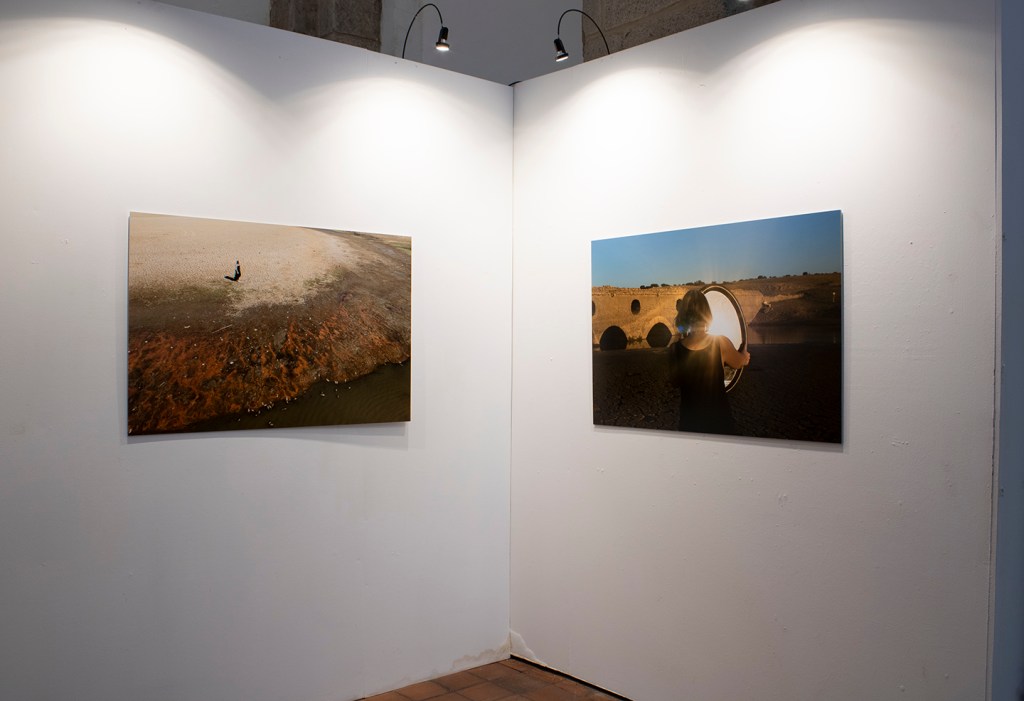Serpent Woman, Sherry Wiggins and Luis Branco, 2021
Luis Branco and I are excited to be exhibiting fifteen large-scale performative photographs portraying the biblical heroines Eve, Judith, and Salome in the galleries at Seidel City. We have created multiple images of each heroine. These performative photographs narrate our revisioning of each woman in my somewhere-in-her-sixties-year-old form.
All About Eve, Sherry Wiggins and Luis Branco, 2021
Eve (me) is depicted in a snakeskin dress under a quince tree in a stage-set-like mise-en-scène. I combine the Serpent and the original Woman in one form—she is both offering and taking the forbidden fruit, both temptress and tempted. Luis Branco and I shot these images of Eve / the Serpent under the quince tree in the courtyard at the OBRAS Artist Residency in Portugal in 2021.
Forbidden Fruit, Sherry Wiggins and Luis Branco, 2021
I love the artifice created by surrounding the quince tree with black fabric. Some speculate that the forbidden fruit in the Garden of Eden was not an apple but perhaps a quince, a fig, or a pomegranate.
Exit Paradise I, Sherry Wiggins and Luis Branco, 2021
Exit Paradise II, Sherry Wiggins and Luis Branco, 2021
The story of the original temptation and the forbidden fruit baffles me. Why wouldn’t Eve want to know the difference between good and evil which the fruit from the Tree of Knowledge offers? And how did this idea of Eve as the original “dangerous woman” get passed down through millennia? In the large-scale diptych Exit Paradise I and II, Eve/the Serpent sheds her dress/skin as she exits paradise and is forever blamed for her singular act.
Judith and her Maid, Artemisia Gentileschi, 1625
Pictured above is my next heroine Judith, the beautiful Jewish widow who saves her people by seducing the Assyrian General Holofernes only to cut off his head. I particularly love this portrayal by Baroque artist Artemisia Gentileschi. Renaissance and Baroque artists (such as Giorgione, Caravaggio, and Gentileschi) loved the drama, intrigue, and gore of Judith’s story—a tale of power, piety, seduction and revenge. In the ancient biblical tale, “The Book of Judith,” Judith is a pious widow living in the village of Bethulia in Judea. The village is under siege by the Assyrian general and his army, who are camped outside her village. Judith decides to outwit the general and save her people “with God’s hand.” Judith removes her simple widow’s garments and decks herself out in jewels and sumptuous fabrics and goes with her maid to the camp of Holofernes. Judith gains Holofernes’s confidence, explaining that she plans to help him find the best route to conquering her village. Holofernes is charmed and seduced. A feast is held in Holofernes’s tent and he proceeds to drink too much wine. Judith takes advantage of his weakness and decapitates him using his own sword. She takes Holofernes’s head back to her village where they post it on the gate to the village. The Assyrian army is leaderless and in disarray after the murder of their general and they quickly leave Judea. Judith has saved her people and is forever renowned for her bravery and for using her feminine wiles and skills at seduction in the service of God and country.
Judith (after Artemisia Gentileschi), Sherry Wiggins and Luis Branco, 2022
I sometimes re-enact historical paintings of my various heroines, inserting myself into the painting. Judith has been represented as pious and sexy, brave and vengeful, cunning and seductive. Artemisia Gentileschi’s 1625 portrait is particularly interesting to me. Artemisia is another heroine of mine. She was the victim of a sexual predator at a young age and still managed to become one of the most prolific painters of the Baroque period. Artemisia painted many biblical heroines and characters, often painting her own visage onto her subjects. One can see Artemisia’s portrait of Judith as a portrayal of revenge, a me-too act. When I insert my 60-something-year-old-self into this portrait, Judith, Artemisia, and I echo one across time and space.
Judith with the Head of Holofernes, Jan Massys, 1543
The Sadistic Judith? Sherry Wiggins and Luis Branco, 2022
We recreated another portrait of Judith, one by Flemish artist Jan Massys. In The Sadistic Judith?, my bare-breasted Judith stares outward as she grasps the head of Holofernes in one hand and his sword in the other. She is no young, coy maiden, as she is in Jan Massys portrayal; she is, instead, a woman well aware of her brutal accomplishment and power.
The Apparition, Gustave Moreau, 1876
More heads roll in the story of the biblical princess Salome who famously and seductively dances before King Herod. He, in turn, grants her any wish whatsoever. Salome’s story has transfixed many in its multiple versions: in the Gospels of Mark and Mathew and in paintings, plays, and operas over the centuries. Salome has been portrayed as a young, beautiful temptress who, after dancing before King Herod and his guests, asks for the head of John the Baptist on a platter. Why would Salome ask this? The back story is that Salome’s mother, Herodias, married King Herod Antipas after divorcing her first husband, King Herod Antipas’s half-brother. John the Baptist criticized Herodias and King Herod and declared their marriage unlawful, which pissed off Herodias. When Salome asked for the head of John the Baptist, she was following her mother’s demand for revenge. So there are two femmes fatale’s in this story: the vengeful mother and the seductive daughter. Blame the daughter, blame the mother.
The Apparition, Sherry Wiggins and Luis Branco, 2021
One of my favorite renderings of Salome is found in the 1876 Gustave Moreau painting, “The Apparition,” above. In our The Apparition, Salome/me appears before a golden wall in a ghostly gauze, the result of Luis’s magical long exposure. We have printed this image at 72 x 48 inches for the exhibit and it looks great!
The triptych Salome at Sunset I, II, III depicts a contemporary Salome bedecked and bejeweled in a car—the joke being that the beautiful princess Salome is an older woman (in her sunset years) in a rental car, and she even bares her breasts.

Salome at Sunset I, II, III, Sherry Wiggins and Luis Branco, 2021
In the black-and-white image below, Salome for Oscar Wilde, Salome bows forward in a kind of fugue state, perhaps conscious of the results of her deadly wish. In Oscar Wilde’s kind of kinky play Salome, she is actually in love with John the Baptist and kisses his decapitated head.
Salome for Oscar Wilde, Sherry Wiggins and Luis Branco, 2021
These images question views of women throughout history, engaging with ideas of beauty, power, sexuality and aging.
The works in the exhibition are part of the larger project, Our Heroines. Our Heroines includes the works in this exhibition along with other alternative representations of additional heroines from classical, biblical, and other historical contexts. Along with Eve, Salome, and Judith, I have thus far embodied and performed Aphrodite, Helen of Troy, Sappho, Cleopatra, and the ancient Egyptian goddess Isis. My performances of these heroines have been captured in still photographs made with Luis Branco over the last two and a half years. Humor, serious research, feminist critique, and sometimes a little kitsch all coexist in these representations.
We are so happy to be showing these works at Seidel City alongside the works of fabulous artists Kristen Hatgi Sink and Mark Sink. “Exit Paradise” is up through April 30.
Seidel City is open Fridays and Saturdays by appointment from 1 to 4 pm. We have an artist talk on April15 from 2 to 4pm and a closing reception on April 30 from 3 to 6 pm. You can also contact me to see the exhibit at your convenience.
Here is the link to the Seidel City website for more information.

